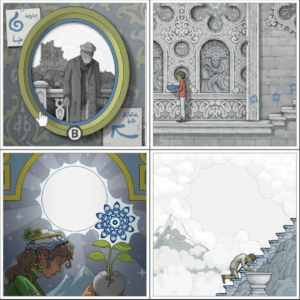For this critical play, I chose to play Gorogoa: its game’s mechanics revolve around manipulating and rearranging a series of beautifully illustrated panels to progress through the game. The puzzles in Gorogoa involve discovering and creating connections between different panels. For example, you might find a character in one panel who needs an item from another panel. By manipulating the panels and arranging them in the correct sequence, you can progress the story and solve the puzzles.
I really enjoyed this game, especially because the hand-drawn artwork and the ability to zoom in and out of panels create an immersive environment. Players can explore intricate details, examine the artwork up close, and engage with the game world on a visual level. This immersion enhances the overall experience and draws players deeper into the story.

The mechanics of Gorogoa also encourage exploration and discovery. Players have the freedom to experiment with different panel arrangements, stacking and overlapping them in various ways. This sense of exploration leads to the discovery of hidden connections, unlocking new paths, and revealing new elements of the narrative. The joy of unraveling these connections and uncovering the story elements adds to the game’s appeal.
An example of this is the puzzle where a character needs to obtain a key to unlock the door.
At the start of the puzzle, you may have two panels side by side. In one panel, you see the character standing in front of a locked door, and in the other panel, you see a table with various objects, including a cup and a candle. Through observation and experimentation, you might notice that the character in one panel is looking towards the table in the adjacent panel. This visual cue suggests that there might be a connection between these two scenes. To progress, you can drag the panel with the character and overlay it partially onto the panel with the table. By aligning the character’s line of sight with the table, you create a connection between the two panels. Now, the character can interact with the objects on the table. In the newly created combined scene, you can guide the character to pick up the cup from the table. Then, you may find another panel that depicts a fountain. By overlapping the panel with the cup on the fountain panel, you create a connection where the character fills the cup with water from the fountain.
The thought process that it took to solve this puzzle was very engaging and made me super invested in the rest of the game.



